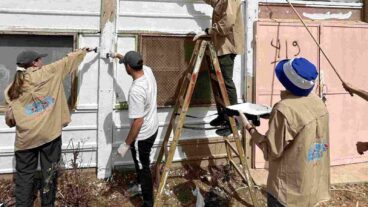Dancers celebrate at the ground-breaking ceremony of the new Agahozo-Shalom Youth Village for children orphaned during Rwanda’s genocideIn 2005 Anne Heyman sent an e-mail message from her Manhattan office to Israel’s director of the Yemin Orde Youth Village. “You don’t know me,” the message began “but I hope you might be able to help me in my mission.”
Said mission was to build a youth village in Rwanda for children orphaned during the late ’90s genocide and model it after the Yemin Orde Youth orphanage in Haifa, Israel.
Yemin Orde director Haim Peeri was forthcoming. He met with Heyman, offered advice and presented a model she could emulate. A mere two years later, Heyman almost had to pinch herself as she stood alongside international dignitaries, Rwandan orphans and Yemin Orde delegates at the groundbreaking ceremony for Agahozo-Shalom Youth Village last week in Rubono, Rwanda.
“Oh my God, this is really going to happen. It is real,” Heyman recounted to ISRAEL21c. “I know we still have lots of planning and lots of work to do to get where we need to be, but this village is real. We are building it. And we really started today.”
The project idea was sparked during a dinner conversation in New York between Heyman, a New York businesswomen and philanthropist, and Paul Rusesabagina, the subject of the film Hotel Rwanda.
“I asked Paul what the biggest problem in Rwanda is and he told me that in a country where there are 1.2 million orphans out of a population of 8 million, there is no future for that country,” said Heyman.
His words motivated her action and soon after the Rwanda Agahozo-Shalom Village began taking shape. The village will provide a comprehensive response to youth displacement by establishing a multi-faceted youth village based on the concept of the village as home. Children are fostered by a holistic, protective environment to help them overcome trauma and abandonment issues.
Agahozo-Shalom is being modeled after Yemin Orde because as a 28-year-old institute, the Israeli village has a reputation for the work it carried out with children who have been orphaned, displaced or traumatized.
A large percentage of Yemin Orde’s children are of Ethiopian origin largely due to trauma and displacement following Israel’s covert 1980s and 1991 airlifts out of Ethiopia. During the lifts, some children were orphaned and others faced cultural hardships upon arrival to Israel.
Today, Ethiopian graduates of Yemin Orde are among Israel’s leaders and motivators. The Agahozo-Shalom Village initiative has incorporated Yemin Orde architectural, educational and philosophical standards and has involved creating joint Rwandan-Israeli-Ethiopian teams that work side by side creating standards for the Rwandan village.
Teams have shuttled back and forth between Rwanda and Israel for more than a year attending meetings and lectures and gleaning information on everything from channeling extra-curricular interests to fostering cultural practices to troubleshooting problem areas.
Rwanda’s team spent long hours on Yemin Orde’s campus to gain information about the philosophies, functions and daily routines of Yemin Orde staff roles and to visually note layouts for modeling learning annexes, living quarters, the dining room and recreation spaces in the Rwanda village.
At last week’s groundbreaking ceremony, the delegations met again as the Ethiopian-Israeli team hoisted the village flag alongside their Rwandan peers. Rwanda’s Eastern District governor introduced Ethiopian-Israeli Advisory Team Director Yisasschar Mekonen by noting that Mekonen had grown up at Yemin Orde and he wanted “the Rwandese children to grow up to be as tall and handsome and elegant as Yisasschar.”
Yemin Orde graduate Ethiopian-Israeli Racheli Ugado has been responsible for providing the Agahozo-Shalom Village philosophy. “I’m here to help my brothers in Africa so that they can help themselves,” she said during a recent delegation collaboration in Israel. “It makes me feel good to help the place I came from. I’m very connected to it. I feel like it’s my country too.”
Among notables attending last week’s ceremony were Israel’s Ambassador to Rwanda Yaakov Amitai, and senior Rwandan government officials.
Education Minister Mujawamariya’s speech on “Restoring the Rhythm of Life” to Rwanda’s children a decade after the genocide included her incorporation of the Hebrew catchphrase “tikun olam” – i.e. helping to make the world a better place – interspersed with KinyaRwandan.
The village and school is expected to be operational by 2009, a dream into action Heyman says couldn’t have happened without help from endless sources including the American Joint Distribution Council and Yemin Orde.
“As a private citizen I think this is a testament to the ability of each and every one of us to make a significant difference in the world,” concluded Heyman. “If you have a good idea and believe in it strongly enough, there are others out there who will be only too glad to help you make it happen.”![]()












